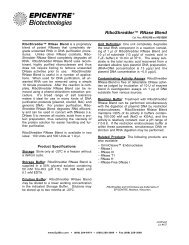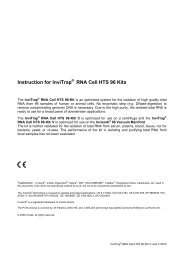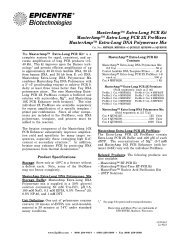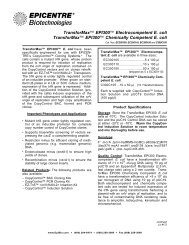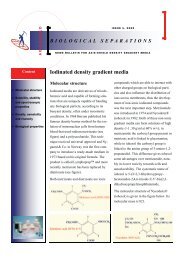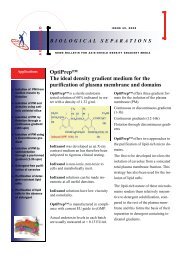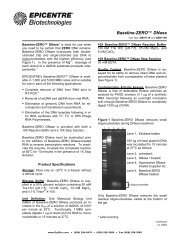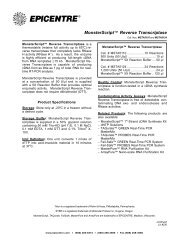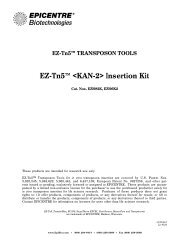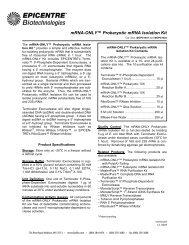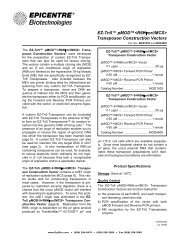Instruction for the Invisorb Spin Cell Mini Kit
Instruction for the Invisorb Spin Cell Mini Kit
Instruction for the Invisorb Spin Cell Mini Kit
- No tags were found...
You also want an ePaper? Increase the reach of your titles
YUMPU automatically turns print PDFs into web optimized ePapers that Google loves.
Buccal swabs:To collect a sample, scrape <strong>the</strong> swab firmly against inside of each cheek 6 times. Air-dry <strong>the</strong>swab <strong>for</strong> at least 2h after collection or use <strong>the</strong>m fresh prepared. Ensure that <strong>the</strong> personproviding <strong>the</strong> sample has not consumed any food or drink in <strong>the</strong> 30 min prior to samplecollection. Best results are obtained if <strong>the</strong> swab stays in <strong>the</strong> lysis solution during lysisprocedure. Use of poor quality starting material influences yield of purified DNA. This protocolis recommended <strong>for</strong> every common swab, like e.g. <strong>the</strong> following swab types: C:E:P: (OmniSwab from Whatman), cotton swab, Superswabs, Copan-Swab or DRACON tip fromHardwood Products company, <strong>Cell</strong>Projects or Hain Diagnostika)<strong>Cell</strong>s grown in suspension:<strong>Spin</strong> up to 1 x 10 7 cells <strong>for</strong> 5 min at 300 x g (1.500 rpm* ). Discard supernatant and remove allmedia completely, taking care not to disturb <strong>the</strong> cell pellet. At this point cells may be frozen (at -20°C or - 80°C) <strong>for</strong> future use or may be used immediately.<strong>Cell</strong>s grown in a monolayer:Aspirate <strong>the</strong> media completely from <strong>the</strong> cells and continue immediately with <strong>the</strong> lysis step.Alternatively cells can be detached by trypsination (cultivation in larger culture vessels, likedishes > 35 mm, flasks > 12.5 cm 2 ). Transfer cells to a 50 ml reaction tube, pellet bycentrifugation at 300 x g (1.500 rpm* ) <strong>for</strong> 5 min and aspirate supernatant completely.ProcedureLysisSamples are lysed at elevated temperatures. Lysis is per<strong>for</strong>med in <strong>the</strong> presence of LysisBuffer D.Binding genomic DNABy adding Binding Buffer HL to <strong>the</strong> lysate, optimal binding conditions will be adjusted.All lysate is applied to a spin filterRemoving residual contaminationsContaminants are efficiently washed away using Wash Buffer, while <strong>the</strong> genomic DNAremains bound to <strong>the</strong> spin filter.ElutionGenomic DNA is eluted from <strong>the</strong> spin filter using 30 - 200 Al Elution Buffer D. The eluted DNAis ready <strong>for</strong> use in different downstream applications. Eluted DNA stored at 4 – 8°C is stable <strong>for</strong>2 months or <strong>for</strong> more than 5 years if stored at -20°C.Yield and quality of genomic DNAThe amount of purified DNA using <strong>the</strong> <strong>Invisorb</strong> ® <strong>Spin</strong> <strong>Cell</strong> <strong>Mini</strong> <strong>Kit</strong> procedure, depends on <strong>the</strong>strain, <strong>the</strong> number of cells in <strong>the</strong> sample, <strong>the</strong> sample source, transport conditions, storage, andage of <strong>the</strong> sample.Yield and quality of isolated genomic DNA is suitable <strong>for</strong> any molecular-diagnostic detectionsystem. The diagnostic tests should be per<strong>for</strong>med according to manufacturers’ specifications.8<strong>Invisorb</strong> ® <strong>Spin</strong> <strong>Cell</strong> <strong>Mini</strong> <strong>Kit</strong> 032010




